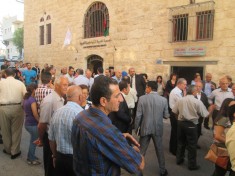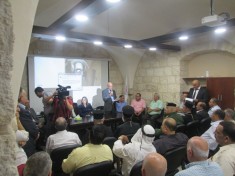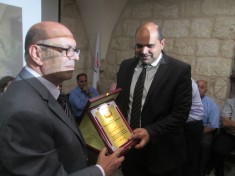Mrs. Rula Ma’aia, Mr. George Ghattas on behalf of the mayor of Beit Sahour, Mr. Lodavico Follin-Calabi Head of UNESCO – Ramallah Office, Mr. Amhad Junaid Sorosh-Wali Head of Culture Unit, UNESCO, Mr. Gunnar Olvik Infrastructure & environment manager at Sida, Clerics and Policemen of Beit Sahour, and number of organizations representative and local community attended the event.
Mr. Ghattas praised the role of each of the Swedish government, UNESCO, the owners of the building and the CCHP for its efforts in reviving the heritage and preserving our cultural identity and contributing to job creation, especially in the ancient town of Beit Sahour.
Arch. Issam Juha, director of CCHP welcomed the honorable guests and pointed out that the rehabilitated projects reduce unemployment by providing jobs and maintaining Palestinian heritage. This project is a complement to the rehabilitation interventions to revive the ancient town of Beit Sahour and give it a touch of aesthetic and develop tourism. Arch. Juha thanked MOTA, Beit Sahour Municipality, Governorate, and Swedish government, UNESCO, owners of the building, project contractor, and CCHP staff for their continuous efforts in preserving the cultural heritage.
In turn, Dr. Elias Is’eed, Chairman of AOCS stressed on the impact of these projects in supporting the active institutions and their role in the revival of the Old City through the vital programmes that encourage the influx of people to the area, and thanked all those who contributed to the success of the project and provide a headquarters the society.
UNESCO office pointed to the importance of these projects in contributing to preserving cultural heritage. It also reflects the civilization and culture of the Palestinian people. Mr. Gunnar from SIDA expressed his joy for being in Beit Sahour and observe the preservation initiatives of the historic town by providing active institutions in community with headquarters.
In turn, H.E. Ma’aia expressed her delight to inaugurate these projects, and thanked the Swedish government through UNESCO for its continuous support for infrastructure projects and traditional buildings to be used for productive, social, cultural and health purposes. She also praised the efforts of CCHP since 2001 in this area, and in providing opportunities for temporary and permanent jobs and adapting buildings for community service.












